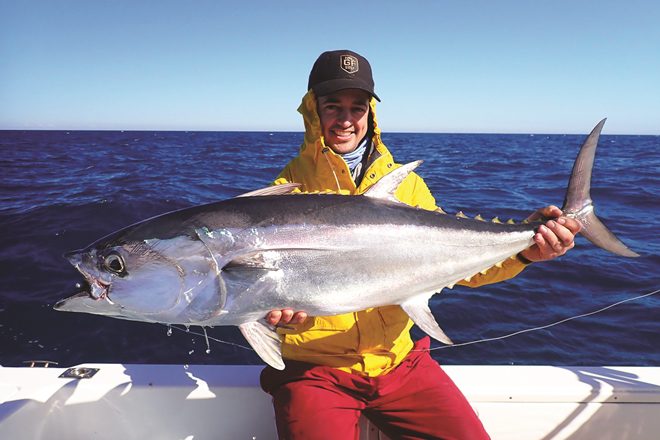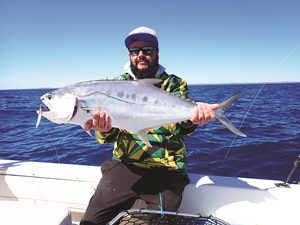
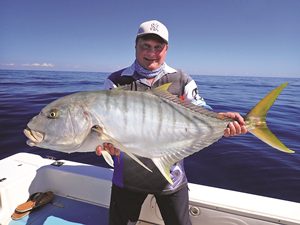
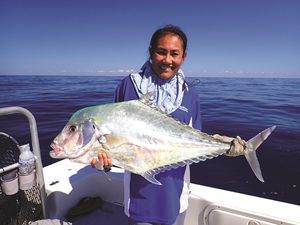
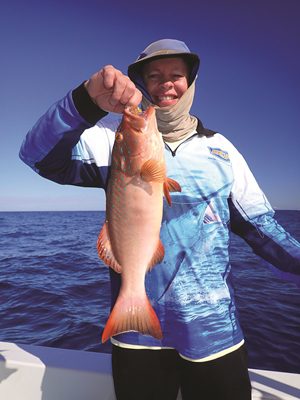
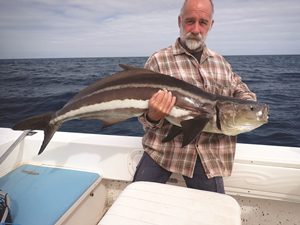
IT’S September already and hard to believe we’ve been in restrictions for so long. It’s now the new norm and I’ve noticed more and more anglers are visiting Hervey Bay for the fishing action. This is good for the local economy, and we are blessed that Queensland’s rates of infection remain low enough for us to continue business in our wonderful sunshine state.
I don’t think many of us could do any more rounds of lockdown, and while we are still restricted, some movement and money are better than none! Another recent restriction was the snapper closure, which I must admit doesn’t really affect me that much. Many other operators would be feeling it, as it is their bread and butter. Hervey Bay action
I don’t keep large snapper to eat anyway, as I generally prefer the pan-sized fish of this species. I have had a few passionate people come to me quite sure that the closure would be something I’d oppose. I often left them speechless when I’d respond with “Yes, its fine, it doesn’t really affect me” and “It’s probably a good thing.”
If the science suggests we need to try something, then what harm could a few years of one-month restrictions do? And it’s only a few weeks of the year when snapper are allowed to do their thing with little interruption from us. If it works, that would be the perfect outcome. Hervey Bay action
We might find the restrictions only need to be practised every three years or so, but who knows? Keep in mind, it’s the future of these fish we want to look after. Putting our heads in the sand will not improve snapper stocks, and it is definitely something we will see more of as we learn more about the species we love and how our interactions with them can alter their future stocks.
It brings to mind issues such as barotrauma, and I believe there is some work to be done on species similar to threadfin salmon. I have seen these fish caught and released in deep water and am itching to see the study on the big fish, especially the metre plus models. I think a few trophy hunters will be upset that they may need to change their methods, especially when targeting these prize fish from deep water. Hervey Bay action
The larger the fish, the larger the swim bladder, so it seems they are more at risk. I am of the opinion that if you catch threadies from deep water, you had better like eating them as well. I have similar issues when fishing depths of over 20m. Some fish just have no ability to cope with the pressure change. Hervey Bay action
I find large diamond trevally and cod are the worst. Diamond trevally over 90cm (I have no idea why) sometimes suffer and sometimes don’t. But you can usually see which fish is suffering badly. Bloated, pop-eyed and bleeding from the anal vent is a very sure sign there is extreme internal damage. Also, if you look closely at the skin, you will see it has parted from the flesh, with what look like small blisters. On fish with scales, you will notice the flared and lifted look of them. These days any fish that is legal and looks compromised is coming home with me to be eaten.
Anyhow, moving on with a quick update from my local area. Wind and rain have been featuring, so thanks very much Mother Nature. I usually expect calm flat afternoons at this time of year, and while we haven’t had much of that, the fishing has still been relatively good, especially considering how tough the weather has made it. Hervey Bay action
Sure, you have to work hard, particularly if you need to fish closer to shore where the species are pressured, and often times you are working around other vessels too. It would make my life easier if the fish keyed in on jigs more often, but plastics are still winning. Windy conditions and light plastics are not an easy route to success!
If you want to join me on a charter, visit the Fraser Guided Fishing website here.
 Bush ‘n Beach Fishing Magazine Location reports & tips for fishing, boating, camping, kayaking, 4WDing in Queensland and Northern NSW
Bush ‘n Beach Fishing Magazine Location reports & tips for fishing, boating, camping, kayaking, 4WDing in Queensland and Northern NSW

